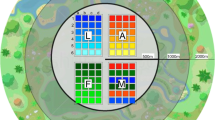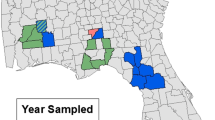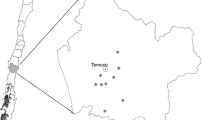Abstract
Bumble bee abundance in agricultural landscapes is known to decrease with increasing distance from seminatural grasslands, but whether the pollination of bumble-bee-pollinated wild plants shows a similar pattern is less well known. In addition, the relative effects of landscape composition (landscape heterogeneity) and landscape configuration (distance from seminatural grassland) on wild plant pollination, and the interaction between these landscape effects, have not been studied using landscape-level replication. We performed a field experiment to disentangle these landscape effects on the pollination of a native herb, the sticky catchfly (Lychnis viscaria), while accounting for the proportion of oilseed rape across landscapes and the local abundance of bee forage flowers. We measured pollen limitation (the degree to which seed set is pollen-limited), seed set, and seed set stability using potted plants placed in landscapes that differed in heterogeneity (composition) and distance from seminatural grassland (configuration). Pollen limitation and seed set in individual plants did not respond to landscape composition, landscape configuration, or proportion of oilseed rape. Instead, seed set increased with increasing local bee forage flower cover. However, we found within-plant variability in pollen limitation and seed set to increase with increasing distance from seminatural pasture. Our results suggest that average within-plant levels of pollen limitation and seed set respond less swiftly than the within-plant variability in pollen limitation and seed set to changes in landscape configuration. Although landscape effects on pollination were less important than predicted, we conclude that landscape configuration and local habitat characteristics play larger roles than landscape composition in the pollination of L. viscaria.


Similar content being viewed by others
References
Aguilar R, Ashworth L, Galetto L, Aizen MA (2006) Plant reproductive susceptibility to habitat fragmentation: review and synthesis through a meta-analysis. Ecol Lett 9:968–980. doi:10.1111/j.1461-0248.2006.00927.x
Ashman TL, Knight TM, Steets JA, Amarasekare P, Burd M, Campbell DR, Dudash MR, Johnston MO, Mazer SJ, Mitchell RJ, Morgan MT, Wilson WG (2004) Pollen limitation of plant reproduction: ecological and evolutionary causes and consequences. Ecology 85:2408–2421. doi:10.1890/03-8024
Benjamin FE, Reilly JR, Winfree R (2014) Pollinator body size mediates the scale at which land use drives crop pollination services. J Appl Ecol 51:440–449. doi:10.1111/1365-2664.12198
Bjornstad ON (2009) ncf: spatial nonparametric covariance functions. R package version 1.1-3. http://cran.r-project.org/package=ncf
Blitzer EJ, Dormann CF, Holzschuh A, Klein A-M, Rand TA, Tscharntke T (2012) Spillover of functionally important organisms between managed and natural habitats. Agric Ecosyst Environ 146:34–43. doi:10.1016/j.agee.2011.09.005
Broadhurst LM, Young AG (2006) Reproductive constraints for the long-term persistence of fragmented Acacia dealbata (Mimosaceae) populations in southeast Australia. Biol Conserv 133:512–526. doi:10.1016/j.biocon.2006.08.004
Carvalheiro LG, Biesmeijer JC, Benadi G, Fründ J, Stang M, Bartomeus I, Kaiser-Bunbury CN, Baude M, Gomes SIF, Merckx V, Baldock KCR, Bennett ATD, Boada R, Bommarco R, Cartar R, Chacoff N, Dänhardt J, Dicks L, Dormann CF, Ekroos J, Henson KSE, Holzschuh A, Junker RR, Lopezaraiza-Mikel M, Memmott J, Montero-Castaño A, Nelson IL, Petanidou T, Power EF, Rundlöf M, Smith HG, Stout JC, Temitope K, Tscharntke T, Tscheulin T, Vilà M, Kunin WE (2014) The potential for indirect effects between co-flowering plants via shared pollinators depends on resource abundance, accessibility, and relatedness. Ecol Lett 17:1389–1399. doi:10.1111/ele.12342
Clough Y, Ekroos J, Báldi A, Batáry P, Bommarco R, Gross N, Holzschuh A, Hopfenmüller S, Knop E, Kuussaari M, Lindborg R, Marini L, Öckinger E, Potts SG, Pöyry J, Roberts SPM, Steffan-Dewenter I, Smith HG (2014) Density of insect-pollinated grassland plants decreases with increasing surrounding land-use intensity. Ecol Lett 17:1168–1177. doi:10.1111/ele.12325
Cranmer L, McCollin D, Ollerton J (2012) Landscape structure influences pollinator movements and directly affects plant reproductive success. Oikos 121:562–568. doi:10.1111/j.1600-0706.2011.19704.x
Cussans J, Goulson D, Sanderson R, Goffe L, Darwill B, Osborne JL (2010) Two bee-pollinated plant species show higher seed production when grown in gardens compared to arable farmland. PLoS One 5:11753. doi:10.1371/journal.pone.0011753
Davila YC, Elle E, Vamosi JC, Hermanutz L, Kerr JT, Lortie CJ, Westwood AR, Woodcock TS, Worley AC (2012) Ecosystem services of pollinator diversity: a review of the relationship with pollen limitation of plant reproduction. Botany 90:535–543. doi:10.1890/03-8024
Delmas CEL, Escaravage N, Cheptou P-O, Charrier O, Ruzafa S, Winterton P, Pornon A (2015) Relative impact of mate versus pollinator availability on pollen limitation and outcrossing rates in a mass-flowering species. Plant Biol 17:209–218. doi:10.1111/plb.12200
Diekötter T, Kadoya T, Peter F, Wolters V, Jauker F (2010) Oilseed rape crops distort plant–pollinator interactions. J Appl Ecol 47:209–214. doi:10.1111/j.1365-2664.2009.01759.x
Dietzsch AC, Stanley AD, Stout JC (2011) Relative abundance of an invasive alien plant affects relative native pollination processes. Oecologia 167:467–479. doi:10.1007/s00442-011-1987-z
Ebeling A, Klein AM, Schumacher J, Wolfgang WW, Tscharntke T (2008) How does plant richness affect pollinator richness and temporal stability of flower visits? Oikos 117:1808–1815. doi:10.1111/j.1600-0706.2008.16819.x
Ekroos J, Rundlöf M, Smith HG (2013) Trait-dependent responses of flower-visiting insects to distance to semi-natural grasslands and landscape heterogeneity. Landsc Ecol 28:1283–1292. doi:10.1007/s10980-013-9864-2
Farwig N, Bailey D, Bochud E, Herrmann JD, Kindler E, Reusser N, Schüepp C, Schmidt-Entling MH (2009) Isolation from forest reduces pollination, seed predation and insect scavenging in Swiss farmland. Landsc Ecol 24:919–927. doi:10.1007/s10980-009-9376-2
Garibaldi LA, Steffan-Dewenter I, Kremen C, Morales JM, Bommarco R, Cunningham SA, Carvalheiro LG, Chacoff NP, Dudenhöffer JH, Greenleaf SS, Holzschuh A, Isaacs R, Krewenka K, Mandelik Y, Mayfield MM, Morandin LA, Potts SG, Ricketts TH, Szentgyörgyi H, Viana BF, Westphal C, Winfree R, Klein AM (2011) Stability of pollination services decreases with isolation from natural areas despite honey bee visits. Ecol Lett 14:1062–1072. doi:10.1111/j.1461-0248.2011.01669.x
Ghazoul J (2005) Pollen and seed dispersal among dispersed plants. Biol Rev 80:413–443. doi:10.1017/S1464793105006731
Gonzalez-Varo JP, Biesmeijer JC, Bommarco R, Potts SG, Schweiger O, Smith HG, Steffan-Dewenter I, Szentogyörgyi H, Woyciechwski M, Vilà M (2013) Combined effects of global change pressures on animal-mediated pollination. Trends Ecol Evol 9:524–530. doi:10.1016/j.tree.2013.05.008
Goverde M, Schweizer K, Baur B, Erhardt A (2002) Small-scale habitat fragmentation effects on pollinator behaviour: experimental evidence from the bumblebee Bombus veteranus on calcareous grasslands. Biol Conserv 104:293–299. doi:10.1016/S0006-3207(01)00194-X
Hadley AS, Betts MG (2012) The effects of landscape fragmentation on pollination dynamics: absence of evidence not evidence of absence. Biol Rev 87:526–544. doi:10.1111/j.1469-185X.2011.00205.x
Holzschuh A, Dormann CF, Tscharntke T, Steffan-Dewenter I (2011) Expansion of mass-flowering crops leads to transient pollinator dilution and reduced wild plant pollination. Proc Roy Soc B 278:3444–3451. doi:10.1098/rspb.2011.0268
Jakobsson A, Ågren J (2014) Distance to semi-natural grassland influences seed production of insect-pollinated herbs. Oecologia 175:199–208. doi:10.1007/s00442-014-2904-z
Jakobsson A, Lázaro A, Totland Ø (2009) Relationships between the floral neighborhood and individual pollen limitation in two self-incompatible herbs. Oecologia 160:707–719. doi:10.1007/s00442-009-1346-5
Jennersten O, Berg L, Lehman C (1988) Phenological differences in pollinator visitation, pollen deposition and seed set in the stinky catchfly, Viscaria vulgaris. J Ecol 76:1111–1132. http://www.jstor.org/stable/2260638
Kennedy CM, Lonsdorf E, Neel MC, Williams NM, Ricketts TH, Winfree R, Bommarco R, Brittain C, Burley AL, Cariveau D, Carvalheiro LG, Chacoff NP, Cunningham SA, Danforth BN, Dudenhöffer J-H, Elle E, Gaines HR, Garibaldo LA, Gratton C, Holzschuh A, Isaacs R, Javorek SK, Jha S, Klein AM, Krewenka K, Mandelik Y, Mayfield MM, Morandin L, Neame LA, Otieno M, Park M, Potts SG, Rundlöf M, Saez A, Steffan-Dewenter I, Taki H, Viana BF, Westphal C, Wilson JK, Greenleaf SS, Kremen C (2013) A global quantitative synthesis of local and landscape effects on native bee pollinators in agroecosystems. Ecol Lett 16:584–599. doi:10.1111/ele.12082
Knight TM, Steets JA, Vamosi JC, Mazer SJ, Burd M, Campbell DR, Dudash MR, Johnston MO, Mitchell RJ, Ashman TL (2005) Pollen limitation of plant reproduction: pattern and process. Annu Rev Ecol Evol Syst 36:467–497. doi:10.1146/annurev.ecolsys.36.102403.1
Kohler F, Verhulst J, van Klink R, Kleijn D (2008) At which spatial scale do high-quality habitats enhance the diversity of forbs and pollinators in intensively farmed landscapes? J Appl Ecol 45:753–762. doi:10.1111/j.1365-2664.2007.01394.x
Kovács- Hostyánszki A, Haenke S, Batáry P, Jauker B, Báldi A, Tscharntke T, Holzschuh A (2013) Contrasting effects of mass-flowering crops on bee pollination of hedge plants at different spatial and temporal scales. Ecol Appl 23:1938–1946. doi:10.1890/12-2012.1
Kwak MM, Jennersten O (1991) Bumblebee visitation and seed set in Melampyrum pratense and Viscaria vulgaris: heterospecific pollen and pollen limitation. Oecologia 86:99–104
Mitchel RJ, Flanagan RJ, Brown BJ, Waser MN, Karron JD (2009) New frontiers in competition for pollination. Ann Bot 103:1403–1413
Mustajärvi K, Siikamäki P, Åkerberg A (2005) Inbreeding depression in perennial Lychnis viscaria (Caryophyllaceae): effects of population mating history and nutrient availability. Am J Bot 92:1853–1861. doi:10.3732/ajb.92.11.1853
Öckinger E, Smith HG (2006) Semi-natural grasslands as population sources for pollinating insects in agricultural landscapes. J Appl Ecol 44:50–59. doi:10.1111/j.1365-2664.2006.01250.x
Olsson O, Bolin A (2014) A model for habitat selection and species distribution derived from central-place foraging theory. Oecologia 175:537–548. doi:10.1007/s00442-014-2931-9
Pauw A (2007) Collapse of a pollination web in small conservation areas. Ecology 88:1759–1769. doi:10.1890/06-1383.1
Persson AS, Smith HG (2013) Seasonal persistence of bumblebee populations is affected by landscape context. Agric Ecosyst Environ 165:201–209. doi:10.1016/j.agee.2012.12.008
Persson AS, Olsson O, Rundlöf M, Smith HG (2010) Land use intensity and landscape complexity—analysis of landscape characteristics in an agricultural region in Southern Sweden. Agric Ecosyst Environ 136:169–176. doi:10.1016/j.agee.2009.12.018
Pinheiro J, Bates D, DebRoy S, Sarkar D, R Development Core Team (2011) nlme: linear and nonlinear mixed effects models. R package version 3.1-100. http://cran.r-project.org/web/packages/nlme/nlme.pdf
R Development Core Team (2011) R: a language and environment for statistical computing. R Foundation for Statistical Computing, Vienna. http://www.R-project.org/
Ricketts TH, Regetz J, Steffan-Dewenter I, Cunningham SA, Kremen C, Bogdanski A, Gemmill-Herren B, Greenleaf SS, Klein AM, Mayfield MM, Morandin LA, Ochieng A (2008) Landscape effects on crop pollination services: are there general patterns? Ecol Lett 11:499–515. doi:10.1111/j.1461-0248.2008.01157.x
Rundlöf M, Nilsson H, Smith HG (2008) Interacting effects of farming practice and landscape context on bumble bees. Biol Conserv 141:417–426. doi:10.1016/j.biocon.2007.10.011
Rundlöf M, Persson AS, Smith HG, Bommarco R (2014) Late-season mass-flowering red clover increases bumble bee queen and male densities. Biol Conserv 172:138–145. doi:10.1016/j.biocon.2014.02.027
Steffan-Dewenter I, Tscharntke T (1999) Effects of habitat isolation on pollinator communities and seed set. Oecologia 121:432–440
Steffan-Dewenter I, Westphal C (2008) The interplay of pollinator diversity, pollination services and landscape change. J Appl Ecol 45:737–741. doi:10.1111/j.1365-2664.2008.01483.x
Van Geert A, Van Rossum F, Triest L (2010) Do linear landscape elements in farmland act as biological corridors for pollen dispersal? J Ecol 98:178–187. doi:10.1111/j.1365-2745.2009.01600.x
Wagenius S, Lyon SP (2010) Reproduction of Echinacea angustifolia in fragmented prairie is pollen-limited but not pollinator-limited. Ecology 91:733–742
Westphal C, Steffan-Dewenter I, Tscharntke T (2006) Bumblebees experience landscapes at different spatial scales: possible implications for coexistence. Oecologia 149:289–300. doi:10.1007/s00442-006-0448-6
Westphal C, Steffan-Dewenter I, Tscharntke T (2009) Mass flowering oilseed rape improves early colony growth but not sexual reproduction of bumblebees. J Appl Ecol 46:187–193. doi:10.1111/j.1365-2664.2008.01580.x
Wilson GB, Wright J, Lusby P, Whittington WJ, Humphries RN (1995) Lychnis viscaria L. (Viscaria vulgaris Bernh.). J Ecol 83:1039–1051
Zuur AF, Ieno EN, Walker NJ, Saveliev AA, Smith G (2009) Mixed effects models and extensions in ecology with R. Springer, Berlin
Acknowledgments
We thank Christoffer du Riez, Sofie Sandin, and Benigno Padrón for assisting in the field and collecting capsules from the experimental plants, and Honor C. Prentice and Stefan Andersson for valuable discussions on wild plant pollination. Jennifer Lau and three anonymous reviewers provided valuable comments on an earlier version of our manuscript. This study was supported by the strategic research environment BECC (J.E.), the EU in the FP7 project ‘‘STEP—Status and Trends of European Pollinators’’ (Grant Agreement No. 244090; M.R. and H.G.S.), and grants from Formas (H.G.S. and A.J.). All experiments comply with the current laws of Sweden, where the field experiments were done. The authors declare that they have no conflicts of interest.
Author information
Authors and Affiliations
Corresponding author
Additional information
Communicated by Jennifer A. Lau.
Electronic supplementary material
Below is the link to the electronic supplementary material.
Rights and permissions
About this article
Cite this article
Ekroos, J., Jakobsson, A., Wideen, J. et al. Effects of landscape composition and configuration on pollination in a native herb: a field experiment. Oecologia 179, 509–518 (2015). https://doi.org/10.1007/s00442-015-3370-y
Received:
Accepted:
Published:
Issue Date:
DOI: https://doi.org/10.1007/s00442-015-3370-y




